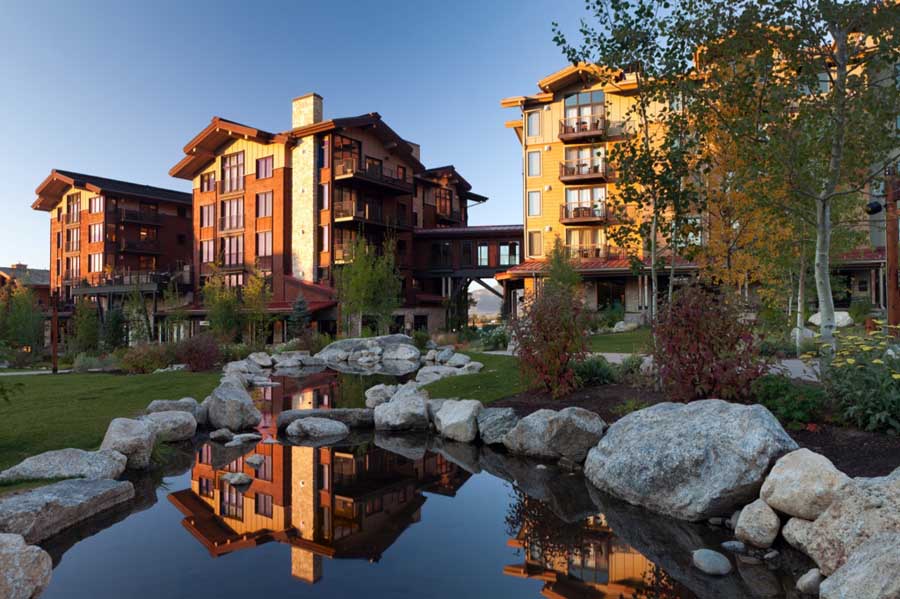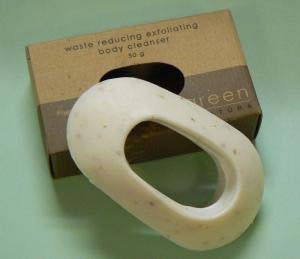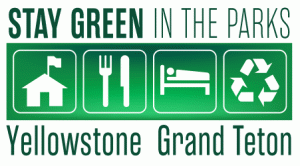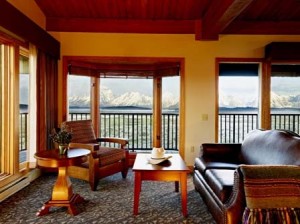
Hotel Terra in Teton Village, Wyo. received a silver certification level from the U.S. Green Building Council. (courtesy photo - click to enlarge)
By Ruffin Prevost
TETON VILLAGE, WYO. — Environmentally conscious travelers can be an outspoken and passionate group, particularly when it comes to staying in marquee national parks like Yellowstone and Grand Teton. They all want to tread lightly, but they sometimes disagree over the best way to do that, even when it comes to something as mundane as bath soap.
Some prefer liquid soap dispensed from refillable bulk containers, while others like the idea of a bar of soap with a hole in the center, giving bathers the feeling of a bigger bar without as much waste. (An elite few travel with their own soap, thank you very much.)

By supplying guests with soap with a "missing middle," a national parks lodging concessioner cuts down on wasted soap.
While eco-friendly soap may seem like a trivial matter, millions of visitors pass through Yellowstone country each year, so the numbers add up. Odd-shaped soap is just one of a wide array of creative innovations local lodging companies are making to operate their properties more sustainably, and to make them more attractive to travelers.
The green travel segment, including ecotourism and geotourism, is growing three times faster than mass market tourism, according to the Center for Responsible Travel, and it could soon make up 25 percent of total travel spending. National Parks typically attract a higher percentage of environmentally conscious travelers than most other destinations, and those guests have high expectations of lodging providers.
“Operating within a national park, the standard is different, and a lot more is demanded of us,” said said Dylan Hoffman, director of environmental affairs in Yellowstone for Xanterra Parks and Resorts.

Click to read more stories from our Stay Green in the Parks series on sustainable dining and loding in Yellowstone and Grand Teton.
Which means, of course, that Hoffman pays lots of attention to soap.
Xanterra is the nation’s largest national and state park concessioner, and the National Park Service expects the company to follow the best possible sustainability practices for all it’s Yellowstone dining and lodging opeartions. That’s part of why Xanterra replaced conventional hotel soaps a few years back in the dozens of park properties it manages with a bar that’s missing its center. The move eliminates much of the waste that goes with millions of discarded soaps after millions of overnight stays.
But longtime visitors to Yellowstone have fond memories of a different kind of soap — one shaped like a cuddly bear. The popular bear soaps are a favorite keepsake of visitors, and Xanterra in Yellowstone still supplies them to its Yellowstone guests. But the company recently got rid of the individual cardboard boxes that each bear was shipped in, and instead has its supplier bag them in bulk. Hoffman figures the move has kept a string of cardboard boxes that would have stretched nearly 10 miles long from entering the landfill each year. At the same time, the company switched from a supplier in China to one in Vermont.

A Yellowstone loding company eliminated individual cardboard boxes used in shipping souvenir bear soaps, removing that material from its waste stream.
At the Old Faithful Snow Lodge during winter, Xanterra must bring in all Yellowstone food and other supplies by snow coach, and take garbage out the same way. So the incentive to reduce, reuse and recycle takes on an extra dimension.
That’s why Xanterra Yellowstone managers listened closely when maintenance workers started speculating about whether they could mix used cooking oil with the diesel fuel used to heat hotels. The company serves nearly 2 million meals in Yellowstone each year, producing 52,000 pounds of waste vegetable oil that must be trucked hundreds of miles away for processing and recycling. Now, much of that waste vegetable oil is filtered and then mixed in as a kind of clean-burning biodiesel to keep winter guests warm.
“It saves time and money,” Hoffman said. “Sometimes the easiest thing ends up having social and environmental benefits.”
That’s exactly what managers at Chico Hot Springs Resort realized after taking a closer look at how their plastic was being recycled. The end result was a move that is better for the environment, and even helpful for guests looking to shed a few pounds.
Tracking the plastic
Staff members from the Pray, Mont. resort participated in the Uncommon Sense sustainability leadership program offered by the Yellowstone Business Partnership. As part of that training, they tracked what happened to Chico’s recyclables, and found that their plastic bottles were being trucked to Bozeman, Mont. where they were crushed and transferred to Seattle. From there, they traveled by ship to China to be recycled into fleece clothing that was shipped back to the U.S. The long and convoluted carbon footprint of their recycled plastic surprised Chico managers.
“Sometimes you just hear ‘recycle’ and think, ‘great!'” said Chico general manager Colin Davis. “But this turned out not to be so great.”

Chico Hot Springs resort switched from plastic soda bottles to aluminum cans in its vending machines to improve its recycling efforts. (courtesy photo - click to enlarge)
So Chico contacted its soft drink suppliers and had them switch the resort’s vending machines to ones that dispense 12-ounce aluminum cans instead of 20-ounce plastic bottles. The aluminum is more easily recycled closer to home, Davis said, and the smaller serving size is healthier for everyone.
“The soda companies thought we were nuts. They didn’t want us to go that route,” Davis said. “We make less money on our soda machines than we would, but it’s the right thing to do.”
Chico also uses compostable, corn-based plastic bottles for its guest toiletries, and the resort is working to restart a recycling program that stalled when a change in waste disposal policies by Park County, Mont. made it cost-prohibitive and impractical.
During a recent remodel, Chico had an employee take old drapes and sew them together into custom-made laundry bags that helped streamline housekeeping chores. What would have been trash becomes a favorite new tool for cleaning crews, Davis said.
Like Chico, Grand Teton Lodge Company has opened a new front in the battle against plastic bottles.
“We have eliminated bottled water throughout our entire operations, in food and beverage and in retail,” said said Gina MacIlwraith, GTLC environmental, health and safety director. The company decided to make the change before the sale of plastic water bottles was halted in Grand Canyon National Park.
MacIlwraith said GTLC, which operates Jackson Lake Lodge and other properties in Grand Teton National Park, has diverted close to 15,000 plastic bottles annually from its waste stream. Guests are encouraged to instead use refillable water bottles, topping them off at “hydration stations” the company has installed in park properties, she said.
MacIlwraith said she heard far fewer complaints from guests than she had expected. Staffers are quick to remind guests that tap water in the park is as pristine as any they’re ever likely to drink — including from bottled water producers — and gift shops offer a wide range of refillable bottles, she said.

A project to remodel 385 rooms at Jackson Lake Lodge in Grand Teton National Park included refinishing old furniture on site rather than replacing it. (courtesy photo - click to enlarge)
Though concessioners are limited in the changes they can make to historic properties owned by the Park Service, a 2009 remodel at Jackson Lake Lodge allowed GTLC to make some big strides in sustainability, MacIlwraith said.
Upgrades focused on energy efficiency and water conservation through new lighting and plumbing fixtures, and all new materials like carpet and drapes were manufactured with little or no volatile organic compounds like formaldehyde, she said.
MacIlwraith said an astounding 97 percent of the waste from the remodel was recycled, reused or donated to charities, including every old mattress from 385 rooms. Historic but battered old case goods like headboards and nightstands were refinished on site by company workers, she said.
Meaningful changes
Outside the parks, such exhaustive sustainability efforts are rare, but many hotels are moving in smaller but meaningful ways toward greener operations. Many hotels use eco-friendly bulk cleaning supplies, including the Chamberlin Inn in Cody, Wyo. Others, like The Cody or The Pollard, in Red Lodge, Mont., work to reduce or eliminate use of disposable items like paper cups or plastic cutlery.
Wood flooring reclaimed from the Old Faithful Inn during a remodel is found throughout The Cody, where it was used in baseboards and trim along the walls and floors. The hotel loans bicycles to guests and its courtesy shuttle is a hybrid gas/electric SUV.
Sustainable practices matter to some guests, said Doug Williams, general manager of The Cody, but “it matters to Europeans more than Americans.”
European guests are typically more likely to do research online to find out about a hotel’s sustainability practices, “and they tend to rely on that more when making reservations,” he said.
The Alpine House in Jackson, Wyo. also provides bikes for guests, and follows a number of other rigorous sustainability practices, earning it a certification from Sustainable Travel International, a rarity in Wyoming.

Floorboards removed from Yellowstone Park's Old Faithful Inn during a 2008 remodel were used in the new construction of The Cody hotel in Cody, Wyo. (Ruffin Prevost/Yellowstone Gate)
Certifications by independent, third-party organizations are an important way for properties to clearly communicate their policies and practices, said Janice Brown, executive director of theYellowstone Business Partnership, a regional nonprofit group that promotes sustainable business practices.
Brown said that guests have a growing awareness of — and affinity for — sustainable practices, with Europeans and U.S. travelers from the West Coast leading the way.
“There is a growing interest in sustainability in travel, but this region is behind California, Oregon and Washington in that,” including in how property owners operate, Brown said.
Forty-eight percent of Yellowstone Gate readers in a recent non-scientific poll said they strongly favor businesses with solid sustainability policies.
Red Rock Ranch in Kelly, Wyo. has been improving Crystal Creek over several years to create an ideal cutthroat trout habitat, said ranch manager Douglas Hare. Crystal Creek flows through the Gros Ventre Mountains and feeds the Snake River. The dude ranch has worked to refine a stretch of water that has tiered pools, long fishing runs and a variety of fishing spots, each with its own style. Hare said improvements to the creek have helped spawning and reduced erosion.
The gateway community hotel perhaps most clearly defined by its sustainable practices is Hotel Terra, in Teton Village, Wyo.
Opened in 2008, the newly constructed property was conceived from the start as a showcase for eco-friendly practices, said JuliAnne Forrest, director of marketing communications for the property.
The hotel received a silver certification for Leadership in Energy and Environmental Design (LEED) from the U.S. Green Building Council. Guests of Hotel Terra sleep in rooms with paints and fabrics that have little or no VOCs. They dry off after a shower with organic cotton towels and sleep on organic cotton sheets. The sheets top a mattress made with recycled steel springs and natural latex rubber.
Low-flow water fixtures and efficient LED lights are among the typical and expected green building mainstays at Hotel Terra, but the property also sports dozens of other touches like chairs made with recycled seat belts, reused pickle barrel tops in balcony construction and recycled glass used in bathroom countertops.
It might be impossible to list all of the eco-friendly touches at Hotel Terra, but it’s also hard to miss at least a few of them by the end of a stay.
“When we do get guests who aren’t aware of all that we do, and maybe they find out we’re LEED certified or learn about the extra steps we take, they’re always very pleased,” Forrest said.
Like Williams and Brown, Forrest said European visitors tend to be more aware of and interested in environmental issues at the hotel. The property’s web site has a lengthy list of key sustainability points.

Opened in 2008, the Terra Hotel in Teton Village, Wyo. was built using a wide range of energy efficient and envrionmentally friendly materials and construction techniques. (courtesy photo - click to enlarge)
Brown said many business owners are learning that being good to the environment can be good for business, saving money and helping the bottom line.
Some practices like purchasing green power offsets — as Hotel Terra and Alpine House do — cost a little more. But not so much more as to make their rates uncompetitive, Forrest said.
Davis, the general manager at Chico Hot Springs, said his staff has found success in meeting sustainability goals by working together, being creative and staying open-minded. After all, he said, Chico has a long history of sustainability.
“We don’t make a big deal of it, but we’re fiercely proud of it,” he said.
When the hotel had only 20 rooms, it drew water from a pond on a nearby hill to turn a wheel and generate electricity.
“Now that really was a big deal,” Davis said with a laugh. “We were the first hotel in Montana with electricity.”
Contact Ruffin Prevost at 307-213-9818 or ruffin@yellowstonegate.com.

Really like that the hotel has a good attention to detail.
The best thing about setting up a policy for sustainable practices is that you can keep tweaking it and improving it.
Keep up the good work!